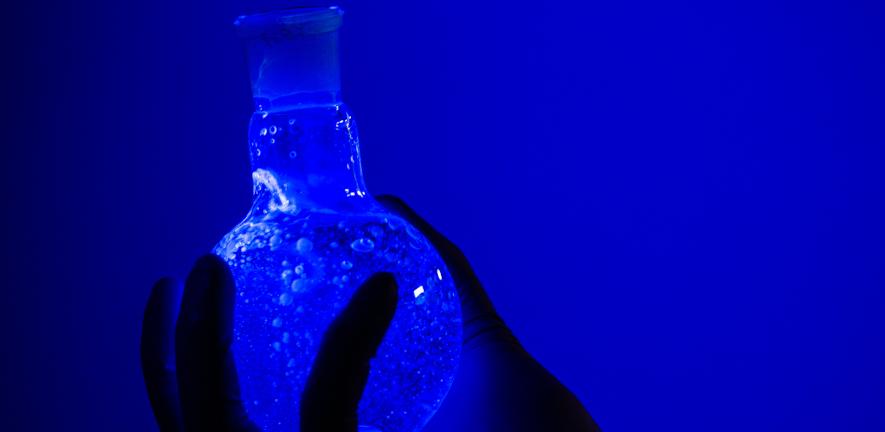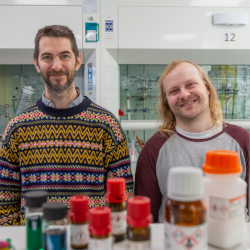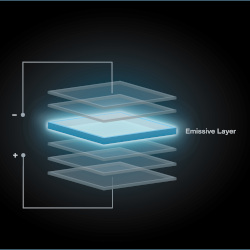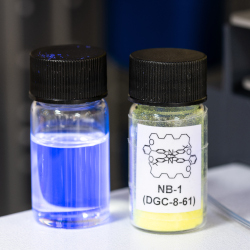

Professor Hugo Bronstein (l) and Dr Daniel Congrave, who led the research
OLEDs are a class of organic electronics that are already found commercially in smartphones and displays and can be more efficient than competing technologies. But although OLED television screens have vivid picture quality, they have certain drawbacks such as high cost and comparatively short lifespans.
In a paper published today in Nature Materials, the researchers from Cambridge, Imperial, Loughborough and Northumbria universities describe a new design which overcomes these issues and may lead to simpler, less costly systems with purer and more stable blue light.
The blue OLED problem
Video of the new OLED molecule glowing blue under UV light, credit Petri Murto
In the most advanced OLED displays, screen pixels are composed of three different coloured subpixels – red, green and blue – that light up at different intensities to create different colours. However, the subpixels that emit blue light are the least stable and can be susceptible to screen ‘burn-in,” which can discolour the screen and ruin viewing quality.
Although some progress has been made to optimise blue OLEDs, this new discovery is simpler, more stable and less expensive.
“OLED screens have great picture quality and carry a high premium. However, OLED TVs don’t last as long as other screens. Pixels that emit blue light are essential for a practical display but are also where the problems lie,” said co-corresponding author Dr Daniel Congrave, who recently completed a Herchel Smith Fellowship at the University of Cambridge, and is now an independent researcher working in Professor Hugo Bronstein’s research group.
An OLED sandwich

The OLED device structure has several layers, like a sandwich, credit Lucy Walker.
An OLED is built like a sandwich, with organic semiconductor layers between two electrodes. In the middle of the stack is the emissive layer, which lights up when powered with electricity. Electrical energy goes into the molecules , which then release this extra energy as light.
An ideal OLED turns most of the electric energy into light, but sometimes the energy gets diverted and degrades the structure of the OLED. This is especially a problem with blue light, and reduces the OLED efficiency and lifetime. The design of efficient OLEDs comes down to managing how the structure of an OLED can channel energy constructively.
A new molecule
To solve this problem, Congrave and co-corresponding author Bronstein decided to design a new light emitter molecule.
The new molecule blocks the destructive energy pathways. The imaginative leap was to add shields to the emitter, which controls how the molecules interact.
“We’ve designed a molecule that’s allowed us to simplify the emissive layer of the blue pixel to only two components, while maintaining high efficiency, which could help to drive down cost,” said Congrave. “The molecule we describe in this paper is also one of the narrowest emitting blue molecules out there, which is very useful for screens because it allows for high colour purity.”
 Molecular structure of the OLED molecule with solution glowing blue, credit Petri Murto.
Molecular structure of the OLED molecule with solution glowing blue, credit Petri Murto.
Co-author Dr Marc Etherington, Assistant Professor at Northumbria University, said: “With this new molecule we have created a channel to develop more efficient OLEDs that will drive down the energy consumption of our devices in the information era. As we all work towards net zero targets, this could have a significant impact for both manufacturers and consumers.”
Co-first author Dr Hwan-Hee Cho, a postdoctoral researcher in Professor Richard Friend’s group in the University of Cambridge Cavendish Laboratory, designed the OLED devices. Cho said: “This research will contribute to the next generation of blue OLEDs that achieve high efficiency, brightness, stability, and colour purity simultaneously.'
Research
H. Cho, D. G. Congrave, A. J. Gillett, S. Montanaro, H. E. Francis, V. Riesgo-Gonzalez, J. Ye, R. Chowdury, W. Zeng, M. K. Etherington, J. Royakkers, O. Millington, A. D. Bond, F. Plasser, J. M. Frost, C. P. Grey, A. Rao, R. H. Friend, N. C. Greenham and H. Bronstein, Suppression of Dexter Transfer by Covalent Encapsulation for Efficient Matrix-Free Narrowband Deep Blue Hyperfluorescent OLEDs, Nature Materials (2024).

